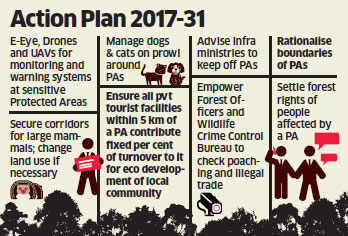What are the key areas of the
draft NWAP ?
Integrating climate change into
- wildlife
planning,
- mitigation
of human-wildlife conflict,
- coastal
and marine ecosystem conservation
- focus
on wildlife health
are among the key areas of the draft National Wildlife Action Plan
(NWAP) 2017-31 unveiled by the environment ministry recently.

pehle kab aaya tha NWAP ?
- The
first NWAP was adopted in 1983, while the second was adopted in 2002,
which is drawing to an end this year.
aur kya bolta hai draft ?
- The draft NWAP envisages 17 focus areas, including the new area linking wildlife planning to climate change.
- The draft’s emphasis on aspects like preservation of genetic diversity and sustainable utilization of species and ecosystems have a direct bearing on the country’s scientific advancements and support to millions of rural communities.
- It also suggests a landscape approach to conservation of all uncultivated flora and undomesticated fauna that have ecological value irrespective of where they occur.
- The draft accords special emphasis to rehabilitation of threatened species of wildlife while working on conservation of their habitats, including inland, aquatic, coastal and marine ecosystems.
- The draft also takes note of concerns relating to effects of climate change on wildlife by integrating them into wildlife management planning.
- The draft NWAP points to the alarming erosion of natural heritage comprising of rivers, forests, grasslands, mountains, wetlands, deserts as well as coastal and marine habitats.
- It noted that despite being “one of the 12 mega biodiversity countries of the world, national planning has not taken serious note of adverse ecological consequences of reduction and degradation of wilderness areas from the pressures of population, commercialization and development projects.
- One of the highlights of the draft plan is the focus on “wildlife health”, which it describes as yet another area that needs urgent attention.
- “The
recent emergence of the tiger as a new host for canine distemper, the geographic
spread of endotheliotropic herpes virus among elephants and reports of goat pox in goat antelopes of north-eastern
India only reiterate the need for
urgent measures for protecting Indian wildlife against diseases,” the
draft stressed.
Expert opinion ...what must
NWAP address ?
- Along with the need to address traditional concerns related to wildlife like strengthening and effective management of protected areas, restoration of degraded habitats, controlling poaching, it has become very important to address new-age concerns.
- For instance, rapid industrialization is shrinking wildlife habitat and triggering human-wildlife conflict.
- Also,
climate change is affecting wildlife as well.

